Contributory members are able to log private notes and comments about each site
Sites Anne T has logged. View this log as a table or view the most recent logs from everyone
Coneypark Nursery (Cambusbarron)
Trip No.108 Entry No.6 Date Added: 10th Nov 2018
Site Type: Cairn
Country: Scotland (Stirling)
Visited: Yes on 31st Oct 2018. My rating: Condition 2 Ambience 3 Access 5

Coneypark Nursery (Cambusbarron) submitted by peigimccann on 24th Dec 2017. Coneypark mound photo by David Sibbald
(View photo, vote or add a comment)
Log Text: Coneypark Nursery Cairn: This cairn is right in the middle of a modern housing estate, where it has been left as a corner ‘open space’. The sides of the cairn have been marginally cut away to create the road and the gardens for the houses, but it is possible to walk over the cairn. A few of the residents were arriving home and in their driveways; none of them took (much) notice of me taking photographs and having a walk all around the cairn.
There is nothing much to see here, but it was ‘one to tick off our list’.
St Thomas's Well (Cambusbarron)
Trip No.108 Entry No.5 Date Added: 10th Nov 2018
Site Type: Holy Well or Sacred Spring
Country: Scotland (Stirling)
Visited: Yes on 30th Oct 2018. My rating: Condition 3 Ambience 4 Access 5

St Thomas's Well (Cambusbarron) submitted by peigimccann on 27th Sep 2016. St Thomas's well pond.
(View photo, vote or add a comment)
Log Text: St Thomas's Well, Cambusbarron: St Thomas’s Well is not far from the rock art panel. Going back to the car, we drove further down Douglas Terrace, past the grave yard, to where the road (St Thomas’s Well) turns right. The well is just past it’s junction with the Old Turnpike Road.
This well is in a private garden. It is possible to walk all the way round the well pool, but not to access the garden. The pool still had water in it, but only a relatively small amount. The whole pool was around 30m across. At its western side, there was a paved area with a round well basin built into it, but this looked like a garden feature rather than part of the well structure.
By the names and the old buildings, this is obviously a very old location with history, but no longer has the atmosphere with the modern houses built up around the historical sites. The busy M9 lies almost immediately to the west, although the noise of the traffic was masked to some extent by the buildings between the well and the road.
King's Park Cup and Rings
Trip No.108 Entry No.4 Date Added: 10th Nov 2018
Site Type: Rock Art
Country: Scotland (Stirling)
Visited: Yes on 30th Oct 2018. My rating: Condition 3 Ambience 4 Access 4
King's Park Cup and Rings submitted by SolarMegalith on 27th Jun 2017. Cup-and-ring mark on King's Park panel seen in the artificial lighting (photo taken on May 2017).
(View photo, vote or add a comment)
Log Text: King's Park Cup and Rings, Sterling: From Stirling, we headed off to south end of King’s Park which lies south of the A811 Dumbarton Road. The rock art panel is located at the southern end, near the golf course.
We parked on Douglas Terrace and used the little cut-through to the park at the eastern end of the row of terraced houses before its junction with Park Place. We then turned west along the footpath that ran along the bottom of the cliffs, but had to double back and use the footpath and steps up to the golf course, just to the right of the cut-through. From here, we turned west along the footpath. The grid reference is spot on, and the rock had had the turf cleared from it. The low light at this time of the afternoon helped to pick out the motifs.
I wondered what other motifs there might be around here, as the footpath here runs along the top of some small cliffs, but these were heavily wooded.
St Ninian's Well (Stirling)
Trip No.108 Entry No.3 Date Added: 10th Nov 2018
Site Type: Holy Well or Sacred Spring
Country: Scotland (Stirling)
Visited: Yes on 30th Oct 2018. My rating: Condition 3 Ambience 2 Access 5
St Ninian's Well (Stirling) submitted by KiwiBetsy on 16th Oct 2006. It is said that a chapel stood near the well and was still in existence in 1497 but that none of it now remains and the structure now covering the well is a wash house.
(View photo, vote or add a comment)
Log Text: St Ninian's Well, Stirling: This was just over the road from the Wellgreen Carpark, but we had difficulty in finding this well, because of its rather hidden location. Despite the GPS telling us we were only 20m away, we were unable to find it until we saw the footpath leading to Wellgreen Place at the southern side of the A811 Wellgreen Road. Shame the area is used by smokers, as the rubbish is horrible.
Opposite the well, nearer to the office block is a small set of steps leading upwards to a now very much overgrown garden area. The steps are virtually hidden under shrubbery, and although Andrew had a try at climbing up, it was very difficult and we gave up and went onto our next destination.
Butt Well
Trip No.108 Entry No.2 Date Added: 9th Nov 2018
Site Type: Holy Well or Sacred Spring
Country: Scotland (Stirling)
Visited: Yes on 30th Oct 2018. My rating: Condition 3 Ambience 4 Access 4
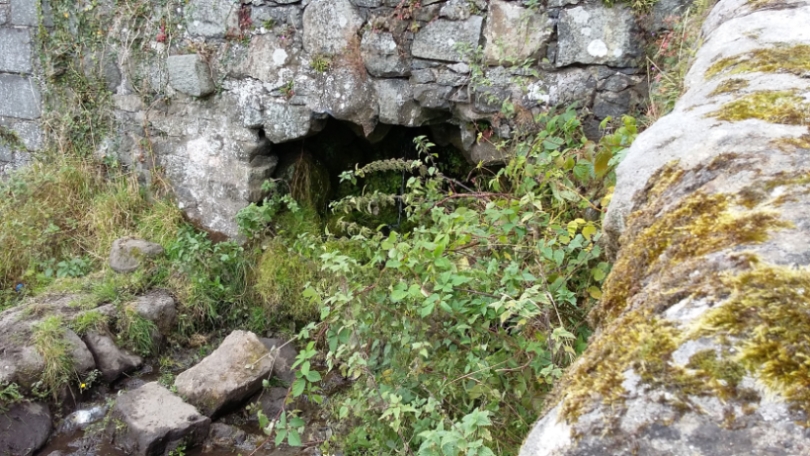
Butt Well submitted by rogerkread on 16th Oct 2015. The waters which would once have flowed into the Butt Well now tumble down the hillside on the far side of the wall behind the wellhead.
(View photo, vote or add a comment)
Log Text: Butt Well, Sterling Castle: We parked in the layby near the King’s Knot, just off the A811. There is a footpath signposted to Butt Well leading through the field next to the layby, just down the grassy slope.
Walking up towards the Castle, we were met by a fair number of dog walkers walking to or from the well. The footpaths here look as if they give access up to the castle, but we stopped short at the well.
Our first sight of part of this feature was a small well chamber, still with a fair flow of water running into it, just over the dry stone wall, below the main well housing and at the bottom of the flight of steps, at NS 78937 93894. The water from this runs in a small channel across the field to the northern side of the wall, at the opposite side to the footpath. Looking down at this chamber from above, there appears to be the remains of a stone drinking trough just outside the chamber, but largely buried under the grass and weeds around it.
The well itself, at NS 78948 93898, is now dry and capped off, with a handy bench next to it.
Climbing up the few steps above the main well housing, there is a channel running underneath the footpath running off to the north west at NS 78952 93902.
As I was photographing the well, a young black Labrador was running around with a large tree branch in his mouth. I was laughing at him, and his owner came up and asked us where we were from. He said when he was young, he used to play on the ‘cup and saucer’ (the King’s Knot) then run up here for a drink; “the water was the clearest you’ll ever taste”. He told me that they’d capped the well off some 20 to 30 years ago.
Randolphfield Stones
Trip No.108 Entry No.1 Date Added: 8th Nov 2018
Site Type: Standing Stones
Country: Scotland (Stirling)
Visited: Yes on 30th Oct 2018. My rating: Condition 3 Ambience 3 Access 4
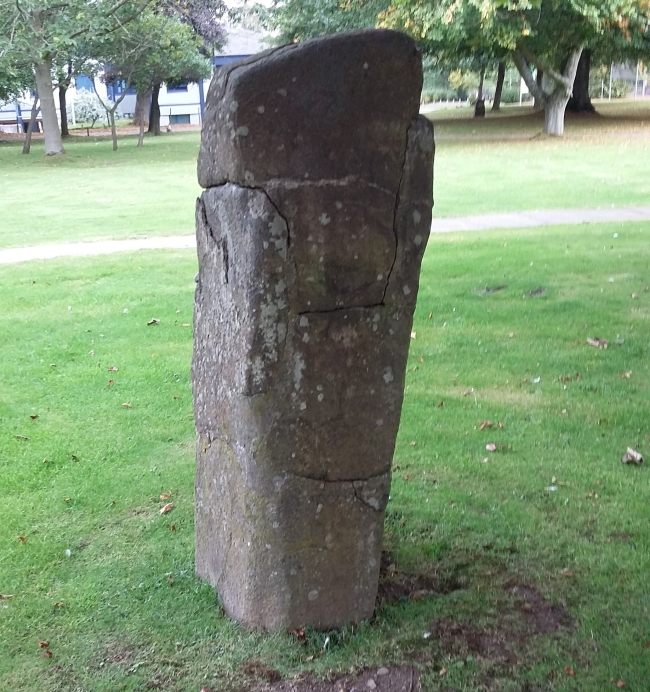
Randolphfield Stones submitted by rogerkread on 16th Oct 2015. The larger stone, showing evidence of destruction and subsequent repair.
(View photo, vote or add a comment)
Log Text: Randolphfield Stones, Sterling: This visit felt really strange, as the stones were literally in front of the police station, and I wondered if I’d get a tap on the shoulder and the memory card from my camera confiscated! No one seemed to turn a hair, though I took a number of photographs of both stones.
The Govan Stones
Trip No.107 Entry No.3 Date Added: 8th Nov 2018
Site Type: Museum
Country: Scotland (North Lanarkshire)
Visited: Yes on 29th Oct 2018. My rating: Condition 3 Ambience 5 Access 5
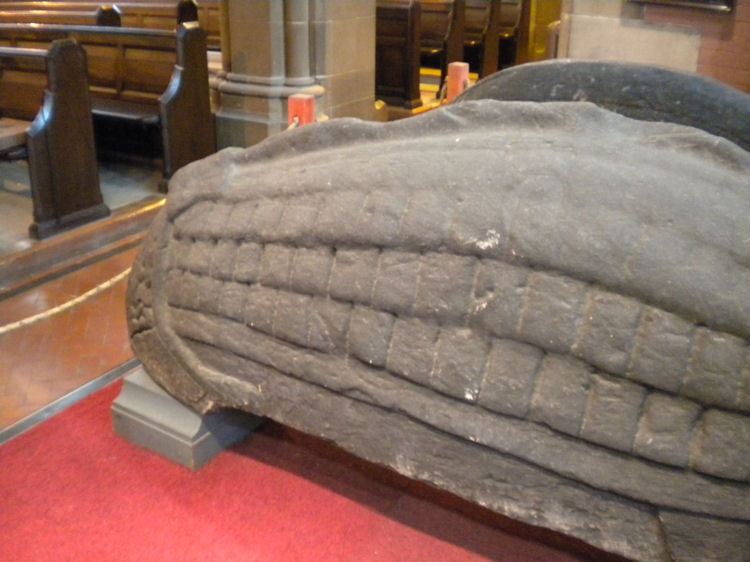
The Govan Stones submitted by joedkins on 19th Jun 2011. Hogback stone in Govan Old Church, Glasgow
(View photo, vote or add a comment)
Log Text: The Govan Stones, Govan Old Church: We only found out about this exhibition/display through a chance email to Glasgow Life, enquiring if St Mungo's Museum of Religious Life and Art next to Glasgow Cathedral had any early Christian stones we could see and photograph. They replied 'no' but told us about The Govan Stones. With only a few days to go before the exhibition closed for the winter on 31st October, we rushed to see it at the first opportunity, and were blown away!
We spent about 2 hours here, wandering around, looking at the stones, hogbacks and the sarcophagus. A guide joined us for part of our visit and put on special lights in which to view the sarcophagus.
I photographed most of the stones, and am still trying to find out more about each one. This exhibition deserves to be much, much wider known than it currently is. It is the best display of early Christian stones that we've seen to date, and I would go again in a heart-beat.
Very, very highly recommended indeed.
Since my visit, I've been in touch with Govan Heritage Trust to find out more information about the stones. They have been immensely helpful and even provided some of the photographs for submission here.
St Mungo's Well (Glasgow Cathedral)
Trip No.107 Entry No.1 Date Added: 7th Nov 2018
Site Type: Holy Well or Sacred Spring
Country: Scotland (North Lanarkshire)
Visited: Yes on 29th Oct 2018. My rating: Condition 3 Ambience 4 Access 4
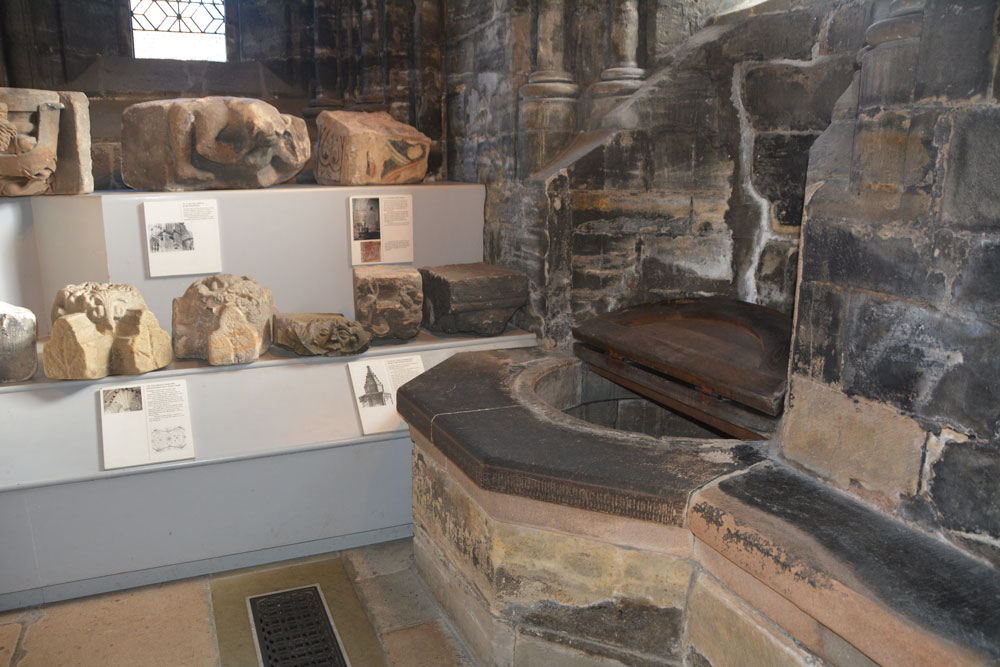
St Mungo's Well (Glasgow Cathedral) submitted by Anne T on 18th Nov 2018. St Kentigern's Holy Well in the south west corner of the crypt, with the small collection of stones from earlier cathedral buildings to its left hand side, against the east wall of the lower crypt.
(View photo, vote or add a comment)
Log Text: St Mungo's/St Kentigern's Well, Glasgow Cathedral: This Cathedral is also known as Barony Kirk, High Church, Metropolitan Kirk & St Mongo’s. The holy well is in the south eastern corner of the crypt/undercroft, next to a collection of architectural fragments and part of the arcade of the original St Mungo’s tomb.
Whilst we were there, the Cathedral guide repeatedly brought people to the well, if only for a brief look. I had to chuckle (only a little) as the well cover made looked like an old fashioned toilet seat. I’m not sure how deep the well is, even with a light, but I couldn’t see any water in it – it was either very deep or dry.
The only mention of this well in the Church’s guide book is on page 16: “In the south east corner of the crypt is St Kentigern’s Well, from which water was drawn for liturgical use. Also in that chapel is a display of carved stones, including possible fragments from the base of St Kentigern’s Shrine, and a painted stone thought to have come from the cathedral of the 1100s.
Lady Well (Glasgow)
Trip No.107 Entry No.2 Date Added: 7th Nov 2018
Site Type: Holy Well or Sacred Spring
Country: Scotland (North Lanarkshire)
Visited: Yes on 29th Oct 2018. My rating: Condition 3 Ambience 3 Access 5
Lady Well (Glasgow) submitted by KiwiBetsy on 23rd Sep 2006. Site in Renfrewshire The well used to flow from the east bank of the Merchants Park, but when this was converted to the Necropolis, the well became polluted and was closed. In 1836, The Merchants House built a niche on the spot to mark the site of it’s exit from the brae. This was rebuilt in 1874.
(View photo, vote or add a comment)
Log Text: Lady Well, Glasgow: To get to this well, we had to walk through the path to the south of the cathedral leading to the Necropolis, then use a gate at the junction of Wishart Street and Ladywell Street, walking east towards the dead end of this street. The well is to the northern side of Ladywell Street, opposite an entrance into Tennent’s Wellpark brewery. It is dry, and now somewhat delapidated, although people have left offerings of money.
As the Canmore entry reads, Lady Well was “anciently a holy well dedicated to the Virgin Mary, was probably one of the sixteen public wells in Glasgow in 1736. It used to flow from the E bank of the Merchants' Park, but when this was converted to the Necropolis, the well became polluted and was closed. The Merchants' House, in 1836, built a niche on the spot to mark the site of its exit from the brae. This was rebuilt in 1874.”
A small brass plaque reads: “The Lady Well. Restored by Tennent Caledonian Breweries Ltd. 1983.”
Boar Stone (Armadale)
Trip No.106 Entry No.7 Date Added: 6th Nov 2018
Site Type: Natural Stone / Erratic / Other Natural Feature
Country: Scotland (West Lothian)
Visited: Yes on 28th Oct 2018. My rating: Condition 3 Ambience 4 Access 4
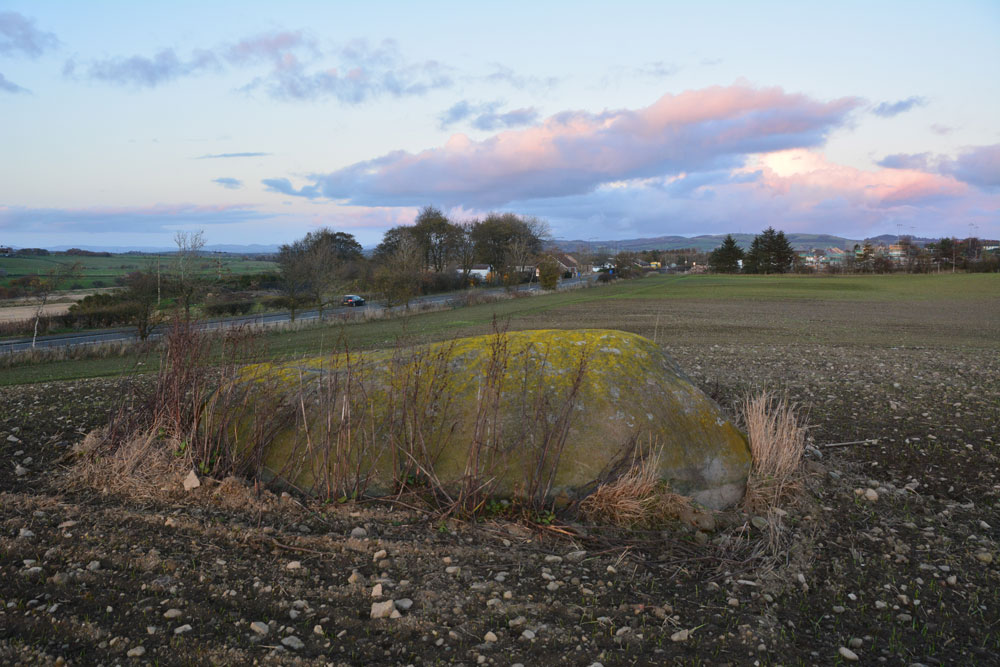
Boar Stone (Armadale) submitted by Anne T on 6th Nov 2018. This photo is looking east over the stone, towards Armadale. Daylight was fading fast, and while there were a few scars and scrapes on top of the stone, we did not see any carvings or markings.
(View photo, vote or add a comment)
Log Text: The Boar Stone (Barbachlaw), Armadale: This is another site we'd picked up from the Ancient Stones website, and although it's not far from my daughter's house in Amadale, we wouldn't normally drive this road. This stone is clearly visible from the A89. We managed to park in the gateway to another field opposite, crossed the road and had to climb over the gate as it was tied shut with some very tight knots.
The field had been planted and there were some young seedlings showing through. By walking along the edge of the field, then up a tractor track, we managed to reach the stone and walk round it.
Goodness knows how much of this stone is underneath the ground – it was certainly large, and no wonder they hadn’t tried to move it!
Gogar Stone
Trip No.105 Entry No.6 Date Added: 6th Nov 2018
Site Type: Standing Stone (Menhir)
Country: Scotland (Midlothian)
Visited: Yes on 28th Oct 2018. My rating: Condition 3 Ambience 4 Access 4

Gogar Stone submitted by Andy B on 13th Mar 2010. Standing stone at Gogar
Copyright M J Richardson and licensed for reuse under the Creative Commons Licence.
(View photo, vote or add a comment)
Log Text: The Gogar or Easter Norton Standing Stone: The last time I visited this stone, the field was planted with crop with no easy way of crossing the knee high rows of plants, so we viewed it from a distance. On this visit, the field had been left fallow, so we parked in the small layby on Freelands Road and walked through a gap in the hedgerow up to the stone. A large rook was perched on top of the stone, but flew off before I could take a photograph of it.
This stone has lots to keep it occupied during the day – planes taking off from Edinburgh airport to the north, trains on the mainline to the south, and cars on the M8. It was nice to be able to wander up to it, take photographs and see the stone up close.
The satnav took us by a funny route back to the A8 and whilst waiting to move off, a white van ran into the back of our car, just as a blue light ambulance was trying to get past. Not a good end to the day, but we decided to stop off at the Boar Stone on the way back as there was still just enough daylight.
Niddrie House
Trip No.106 Entry No.5 Date Added: 6th Nov 2018
Site Type: Standing Stone (Menhir)
Country: Scotland (Midlothian)
Visited: Yes on 28th Oct 2018. My rating: Condition 3 Ambience 2 Access 5
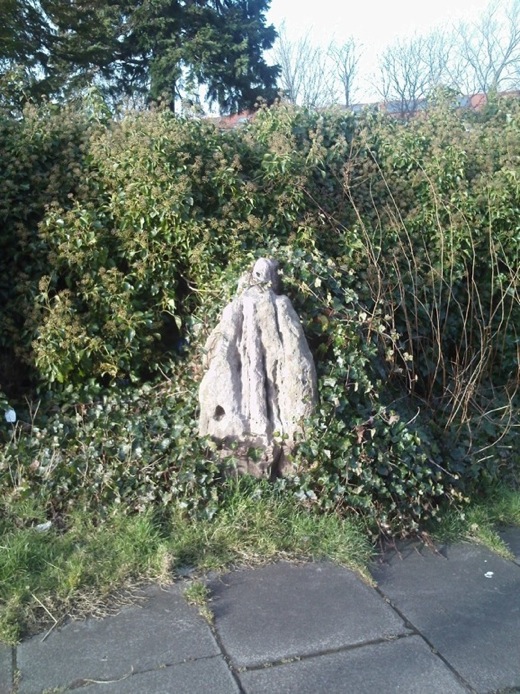
Niddrie House submitted by crannog on 27th Feb 2012. Half-covered in ivy with a great splosh of pink paint covering the top, this wee stone sits surrounded by established housing with new-build developments blossoming all around.
Has one cup mark.
(View photo, vote or add a comment)
Log Text: Niddrie House Stone: This has to be one of the saddest little standing stones I’ve seen. Largely hidden by ivy and surrounded by rubbish, in between a largish utility building and a padlocked, disused cemetery, with a bus stop about 10m to the south west and a new estate with many security cameras to the north east. And a splodge of what was red paint running down from the top of the stone, too. If I could have dug this up and taken it home with me, I would.
Slidey Stane (Holyrood Park)
Trip No.106 Entry No.4 Date Added: 5th Nov 2018
Site Type: Natural Stone / Erratic / Other Natural Feature
Country: Scotland (Midlothian)
Visited: Yes on 28th Oct 2018. My rating: Condition 3 Ambience 3 Access 4
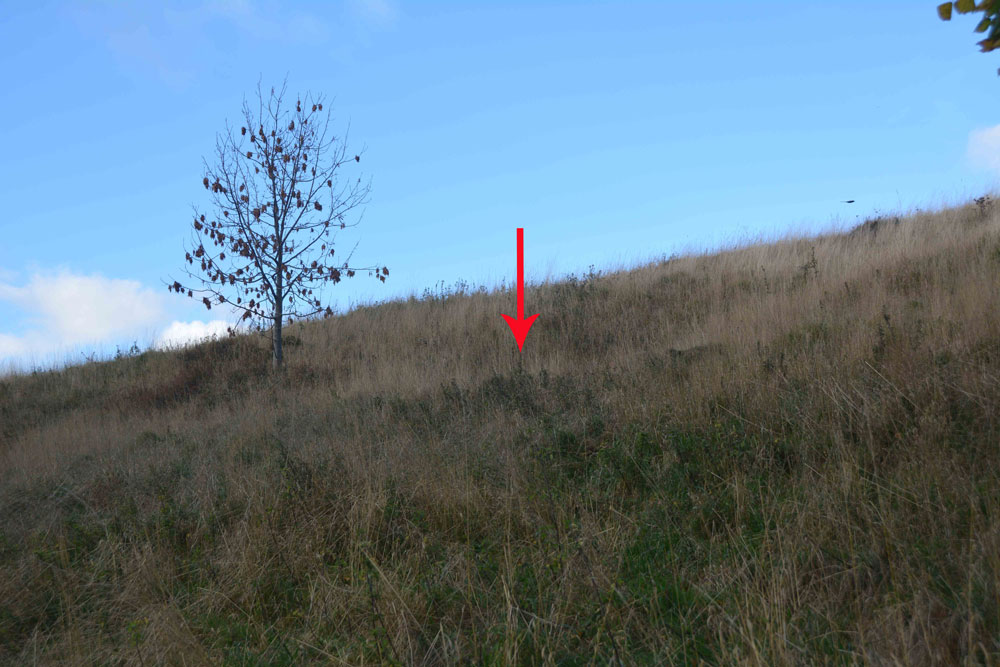
Slidey Stane (Holyrood Park) submitted by Anne T on 5th Nov 2018. The Slidey Stane is well hidden on this hillside, from above and below. From the path below, all that can be seen is a small dip in the slope of the hill. Similarly from the footpath running above the stone, although there are much larger chunks of bedrock sticking up at the side of the path.
(View photo, vote or add a comment)
Log Text: The Slidey Stane, Holyrood Park: As we were in Edinburgh City Centre, we thought we'd try and find this large erratic stone which is featured on The Ancient Stones website, but my goodness - what a search we had!
We followed the directions given on The Ancient Stones, and even armed with the GPS we walked up and down and down and up and round and round. Eventually, I took my phone out and managed to find a forum post on the Modern Antiquarian which gave a link to a search by the park rangers. This, thankfully, included photographs of the route to find the stone. It is in fact at the location given by the Ancient Stones, but is so hidden in a dip on the hillside, that we were unable to see it, either from below or above. We finally saw it from a couple of metres away, but what a disappointment!
The stone is small, although the top is shiny as if it has been polished over the years. There are larger stones on the footpath running above the Slidey Stone.
Well, at least we found it, photographed it and have now posted the results here. We too a more accurate grid reference of NT 26766 72765.
Hanging Stanes (Braid Road)
Trip No.105 Entry No.3 Date Added: 5th Nov 2018
Site Type: Marker Stone
Country: Scotland (Midlothian)
Visited: Yes on 28th Oct 2018. My rating: Condition 2 Ambience 3 Access 5
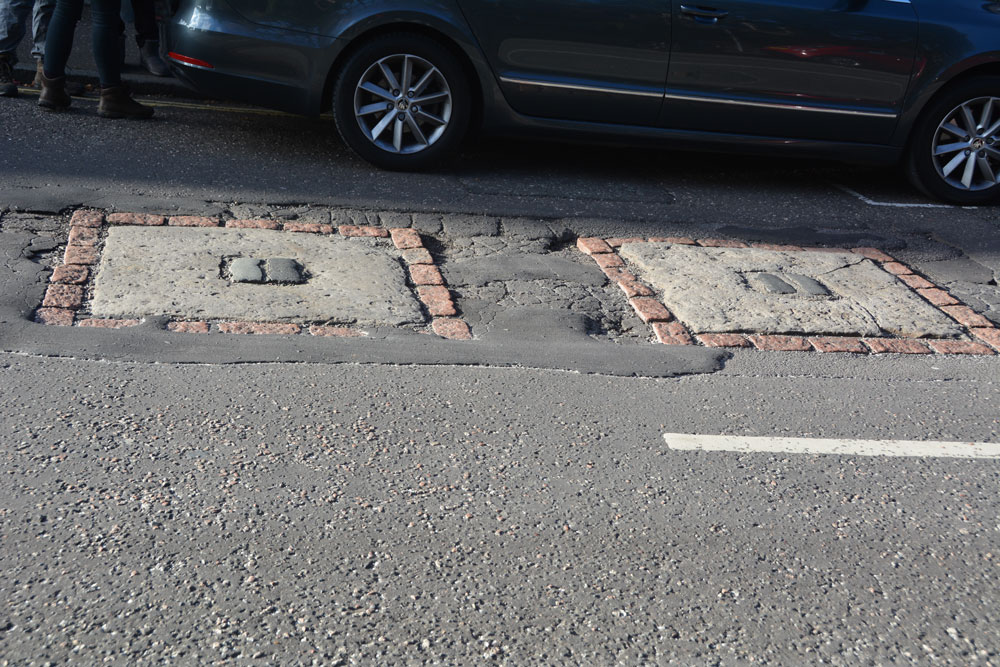
Hanging Stanes (Braid Road) submitted by Anne T on 5th Nov 2018. The two gallow bases are embedded in the road surface. I originally thought this site was associated with witches, but was the site of the execution of the last two highwaymen in Scotland. We picked this site up from the Ancient Stones website, and as it was very close to the Buckstane, thought we'd take a look.
(View photo, vote or add a comment)
Log Text: The Hanging Stanes: Having spotted this site on the Ancient Stones website, and with them being just down the road from the Buck Stane, we decided to pay this site a visit on the way into Edinburgh City Centre. I don't know why I thought these were originally associated with witches, but found out otherwise during the visit.
We pulled up next to the junction of Braid Road and Comiston Road, as per the directions on the Ancient Stones, only to find some people from the house immediately next to it were leaving and getting into their car. The older gentleman from the house asked me if we’d seen the plaque on the street and told me around 30 people each day come to see these stones.
The plaque in the pavement reads: “The Hanging Stanes. Thomas Kelly and Henry O’R eil, the last two highwaymen in Scotland to be executed, were hanged in public on 25th January 1616, from the gallows erected on the two stanes still visible on the spot, which was where the robbery took place. Paid for by public subscription. 1995.”
I risked getting run over to avoid my shadow falling across the stones, but they were half in shade and half in the sun, so the photos weren’t great. With these stones being sited on the slope of a hill with views over the city centre, without the traffic and the people around, this would have been a very atmospheric and enigmatic place.
Caiy Stane
Trip No.106 Entry No.2 Date Added: 5th Nov 2018
Site Type: Standing Stone (Menhir)
Country: Scotland (Midlothian)
Visited: Yes on 28th Oct 2018. My rating: Condition 3 Ambience 4 Access 5
Caiy Stane submitted by crannog on 22nd Feb 2012. Edinburgh council has to be commended for the care they take in preserving ancient sites/monuments, like this. It is located at the end of a street with lots of homes all around.
(View photo, vote or add a comment)
Log Text: The Caiy Stane, Edinburgh: It was a good job we had the SatNav to help us find this stone, as all the streets around were called ‘Caiy (something)’ and we could have been driving around for ages!
This is a magnificent stone, set back in a niche backing onto someone’s garden on Caiystane View. It is possible to walk all the way around it, so we saw the 6 cups marks and the more modern graffiti on the back face.
The small sign at the front base of the stone reads: “The Caiy Stone. The Property of The National Trust for Scotland.” The larger sign, on the low wall to the left of the stone reads: “The Caiy Stane. Standing at over nine feet high on a summit, originally with wide views, this broad slab of red sandstone includes a line of six, probably prehistoric, cup marks on its reverse face. / The stone may have been erected as early as the Neolithic period, possibly before 3000BC, to denote a ritual or burial place. Records of cairns, cists and urns found in the immediate vicinity show that the hilltop continued to be used for burial in the Bronze Age. / Discovery of these remains led to the supposition that Caiyside Hill was the site of a battle, variously suggested to have involved Romans, Danes (Vikings); ore Cromwellians. The Caiy Stane, also known as the Kel Stane, the Cat Stane or the Camus Stane, was thought to have been a battle memorial stone.”
Buck Stane
Trip No.106 Entry No.1 Date Added: 5th Nov 2018
Site Type: Standing Stone (Menhir)
Country: Scotland (Midlothian)
Visited: Yes on 28th Oct 2018. My rating: Condition 3 Ambience 4 Access 5

Buck Stane submitted by Creative Commons on 15th Jan 2014. The Buckstane. The inscription reads:
This march stone, a relic of feudal times occupied a commanding site on the old Roman road about 250 yards north of this spot.
By tradition the name was derived from the stone having marked the place where the buckhounds were unleashed when the King of Scotland hunted in this region.
Copyright Callum Black and licensed for reuse under the Creative Commons Licence.
(View photo, vote or add a comment)
Log Text: The Buck Stane, Braid Road, Edinburgh: Our first stop of the day in the Tour of Edinburgh Stones. The Buck Stone is in a niche on the western side of Braid Road, about 125m north of the junction with Buckstone Drive and before it turns into Buckstone Terrace.
There is a sign explaining what the stone is: The Buckstane. This march stone, a relic of feudal times, occupied a commanding site on the old Roman road about 250 yards north from this spot. By tradition the name was derived from the stone having marked the place where the buck hounds were unleashed when the king of Scotland hunted in this region”.
A nice, tidy, well looked after spot.
Easter Broomhouse
Trip No.105 Entry No.8 Date Added: 5th Nov 2018
Site Type: Standing Stone (Menhir)
Country: Scotland (East Lothian)
Visited: Yes on 27th Oct 2018. My rating: Condition 3 Ambience 4 Access 4
Easter Broomhouse submitted by cosmic on 1st Jun 2008. Site in East Lothian:
Viewed from SE
(View photo, vote or add a comment)
Log Text: Easter Broomhouse Standing Stone: Dusk was falling as we arrived at this site, which I've long wanted to see. We parked by the water treatment works over the road at NT 67718 76493 and walked down the side of the ploughed area of the field until we were level with the stone, then ‘waded’ through the loose, ploughed soil until we reached the stone itself.
A lonely spot, although it has great views to the Firth of Forth and Bass Rock in the distance, to the north. It is a tall, sandstone pillar standing in an ocean of brown-red soil.
There are indeed 3 cups marks on its western face, along with some modern graffiti. The base of the stone has really been worn away; as the Canmore record says, this is the result of a steam plough cable.
St John's Well (Spott)
Trip No.105 Entry No.7 Date Added: 5th Nov 2018
Site Type: Holy Well or Sacred Spring
Country: Scotland (East Lothian)
Visited: Yes on 27th Oct 2018. My rating: Condition 3 Ambience 3 Access 4
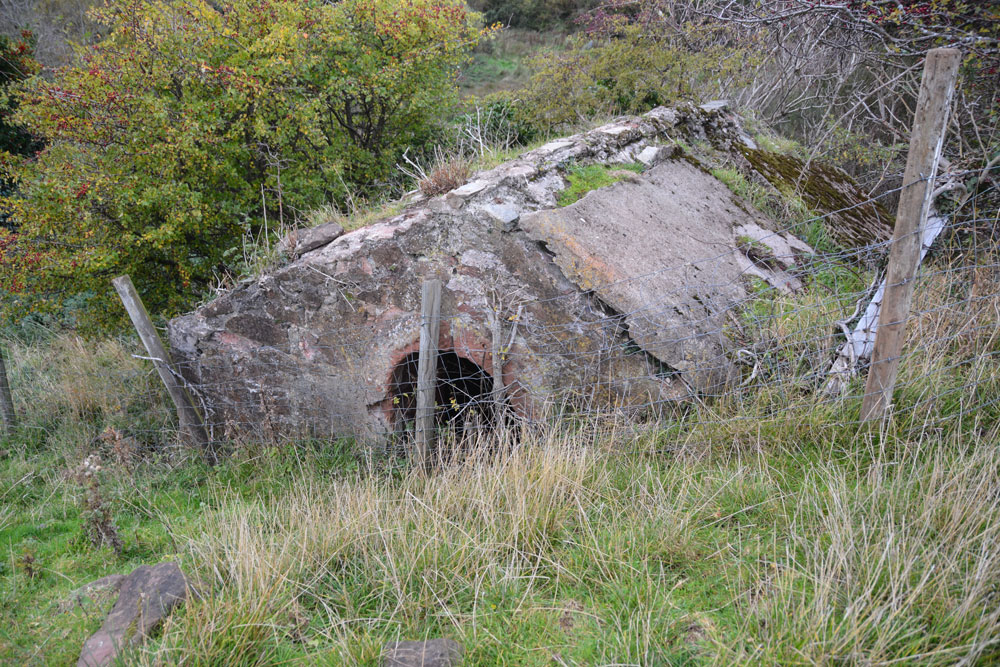
St John's Well (Spott) submitted by Anne T on 5th Nov 2018. This old cistern is some 100m further north, at the eastern side of the gully running from the well. I wondered if it was part of the 18th century works which piped water from this well into Dunbar.
(View photo, vote or add a comment)
Log Text: St John's Well, Spott: With the wind still whistling and starting to get dark, we really wanted to see this well and the nearby Easter Broomhouse standing stone before calling it a day. At the north eastern end of Spott, a gated stile by the small school lets you into the field, which, at the time of our visit, was full of very large, curious sheep.
Following the line of the first two telegraph poles, a gully comes into view. The well house is located at the top of this, at the bottom of the gully, so we needed to slither down the 6ft or so to the bottom to photograph the well.
Whilst the well cavity was dry, there was a pool of water a couple of metres further down the gulley.
Further down the field there was a very old, ruined building with an arched window. I am curious to know what this is – need to look it up on Canmore. Because of its location, my immediate thought was that it was a hermitage. No separate Canmore record, but is recorded on the map as a cistern.
Witches' Stone (Spott)
Trip No.105 Entry No.6 Date Added: 5th Nov 2018
Site Type: Holy Well or Sacred Spring
Country: Scotland (East Lothian)
Visited: Yes on 27th Oct 2018. My rating: Condition 3 Ambience 3 Access 5
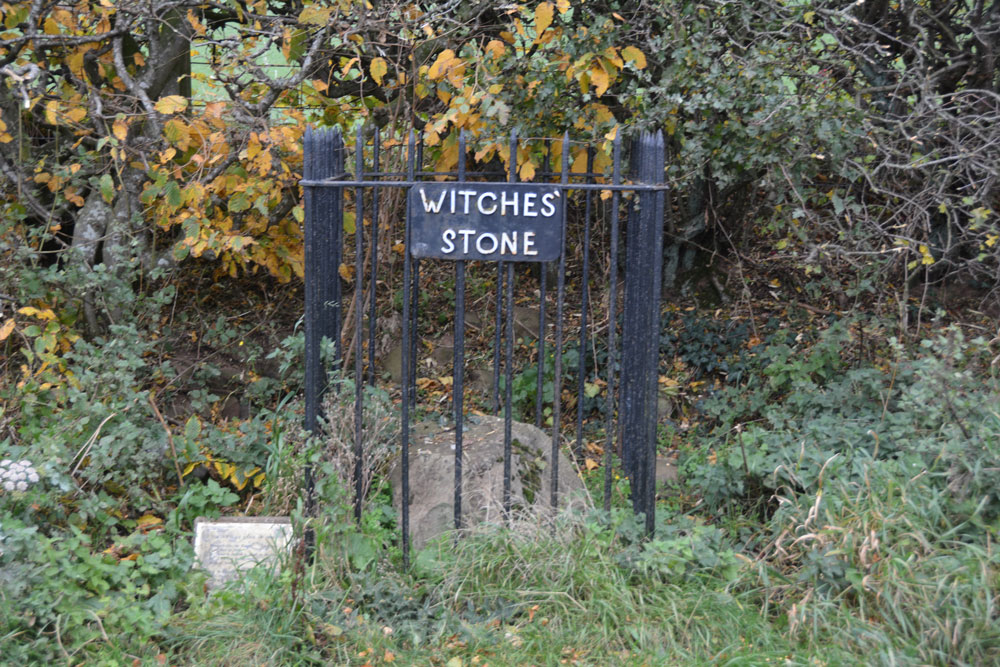
Witches' Stone (Spott) submitted by Anne T on 5th Nov 2018. This unprepossessing stone sits beneath a hedgerow, with a name sign and a small (now almost illegible information sign).
(View photo, vote or add a comment)
Log Text: The Witches' Stone, Spott: I had expected something a little grander than a large stone by the side of a hedgerow with a rusting iron railing and a sign that we could hardly read. There is a photograph on the Canmore record with a photograph of the sign from 2010 which is legible: “The Witches Stone of Spott. Marion Lillie, the Ringwoody Witch was burnt here in 1698. The stone is reputed to stand on the site of the burning of the last witch in the South of Scotland. Near to this site the Birley Tree stood, under whose branches the local Birley Court was held.”
I had to chuckle as whilst I was photographing a stone, another couple had stopped to take photographs of a brown sheep in a nearby field. Having taken quite a few photos, they continued their walk, walking right by this stone. Perhaps they’d seen it before. I found it touching that people still left coins here as offerings.
Rood Well
Trip No.105 Entry No.5 Date Added: 5th Nov 2018
Site Type: Holy Well or Sacred Spring
Country: Scotland (East Lothian)
Visited: Yes on 27th Oct 2018. My rating: Condition 4 Ambience 4 Access 5
Rood Well submitted by KiwiBetsy on 2nd Oct 2006. The Rood Well, also known as The Well of the Holy Rood or the 'Cardinal’s Hat', sits beside the B6370. It is located in a small garden area on the northeastern edge of Stenton, on the left if you are heading for Dunbar.
(View photo, vote or add a comment)
Log Text: Rood Well, Stenton: A very pretty well, and very easy to find. Just by the side of the road, some 300 metres north east along the B6370 from The Tron. The well is below pavement level, with steps leading down to it. The well cavity was damp but there was no pool of water. I couldn’t see any pipe leading into the well chamber, so assume the water must seep up into the cavity. Being closely surrounded by a stone wall on three sides, with a ploughed field beyond, it was a little tricky to photograph.
As the Canmore entry from the Old Church (ID 57841) says, the finial on the well is thought to come from the Old Church (14th century). There is a small plaque on the side of the well which reads: “16th century historic building”.
